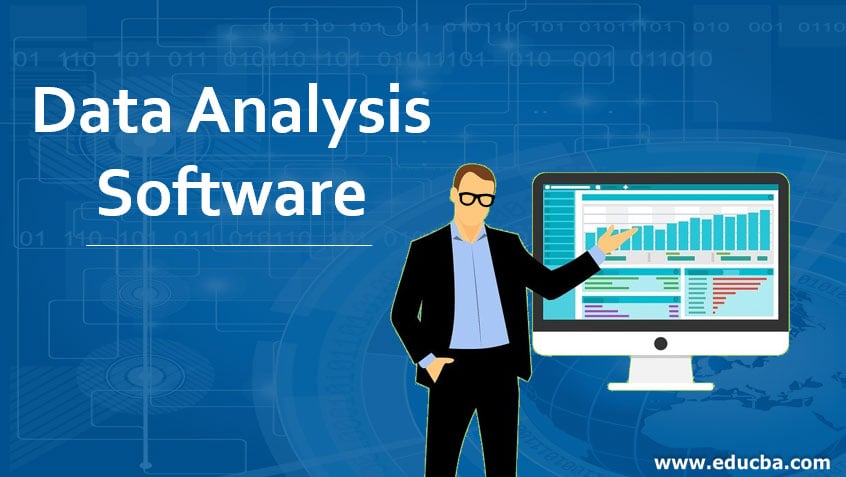Updated June 6, 2023

Introduction to Data Analysis Software
Data Analysis software is defined as a tool that is used to process and manipulate information and analyze the relationship and correlation between the dataset by providing quality analysis like transcription analysis, discourse analysis, grounded theory methodology and content analysis, and decision-making methods using the Statistical and Analytical Capabilities, based upon these capabilities data analysis software is classified as exploratory data analysis and confirmatory data analysis.
What is Data Analysis?
Data Analysis helps clarify, understand, or interpret the individuals and things to assist with qualitative and quantitative information’s meaningful and symbolic content. Qualitative and Quantitative are two fundamental methods of aggregating and interpreting data in the analysis. These strategies can be used independently or simultaneously since they all have the same objectives.
Quantitative analysis is often related to numerical analysis, where data is collected, classified, and then computed for definite findings using a set of statistical methods. Qualitative analysis, on the other hand, is concerned with analyzing information that cannot be quantified and is related to the understanding and insights of objects.
Quantitative and Qualitative research data analysis strategies provide tools that help in transcription analysis, cryptography and text interpretation, algorithmic abstraction, content analysis, and discourse analysis that helps users to avoid wasting time and managing large amounts of information, increase flexibility, and improve validity and suitability of information analysis.
Data Analysis Software Tools
Data Analysis Software tools build it easier for users to process and manipulate information and analyze the relationships and correlations between datasets:
- Data Analysis Software provides tools to assist with qualitative analysis like transcription analysis, content analysis, discourse analysis, and grounded theory methodology.
- Data Analysis Software has the Statistical and Analytical Capability for decision-making methods.
- Data Analysis The software process can be classified into descriptive statistics, exploratory data analysis (EDA), and confirmatory data analysis (CDA).
Types of Data Analysis Software
Several types of Data Analysis Software exist based on business and technology.
The major Data Analysis Software are:
1. NVivo
NVivo is employed for data analysis. It is a program that supports qualitative and mixed strategies analysis. It also helps users to arrange, analyze, and find insights into qualitative data such as interviews, open-ended survey responses, articles, social media, and websites.
- Analyze and organize unstructured text, audio, video, or image information.
- Easily manage your information and enhance your internal workflow and coverage processes.
- Deliver quality outputs backed by a clear discovery and analysis method.
- Increase productivity and scale back project timeframes.
- With NVivo, you can import articles and make transcripts from the reference management code.
2. Transana
Transana is open-source software designed for each – the transcription and analysis of transmission information. With Transana, multiple approaches to the qualitative data analysis of still pictures, audio, and video area unit are possible.
- Transana’s graphical and text-based reports are extremely versatile and customizable.
- It permits users to explore analytic relationships in their data and preserve their insights in a sort of different way.
- The Transana Multi-User version allows synchronous access to multiple researchers to simultaneously figure out the constant data, even from entirely different locations.
- Explore coded information through text/graphical reports.
- With transana, you can code still images using cryptography shapes, including screenshots from video information.
3. MAXQDA
MAXQDA is a skilled software for qualitative, quantitative, and mixed strategies of the data analysis process. It provides researchers with powerful, innovative, and simple-to-use analytical tools that help to make a research project successful.
- MAQDA can assist you with the systematic analysis and interpretation of your data.
- Professionals use it to analyze interviews, reports, tables, online surveys, focus teams, videos, audio files, literature, pictures, and more.
- There are three product options for MAXQDA: MAXQDA Standard, MAXQDA Plus, and MAXQDA Analytics Pro.
- MAXQDA Standard is a Qualitative and Mixed Methods Data Analysis Strategy, MAXQDA Plus is a Quantitative Text Analysis, and MAXQDA Analytics Pro is a module for Statistical Analysis.
- With MAXQDA, you can easily acknowledge different speakers in focus groups, compare their contributions, analyze every speaker, and visualize them in various ways.
4. Qiqqa
Academics, researchers, and businesses employ Qiqqa, an innovative data analysis solution available on the market. You can use it as a vital free research and reference manager to search for, read, and annotate PDFs.
- Qiqqa keeps a user’s PDFs secure, making them instantly accessible and searchable across all devices.
- It helps users to capture all their tags, comments, highlights, and annotations, whereas they scan their PDFs within Qiqqa.
- Users can review their work, write up, and make bibliographies instantly.
- Qiqqa lets consumers find what next to scan by following quotations, authors, and keywords.
5. ATLAS.ti
ATLAS.ti is the leading software for Qualitative Data Analysis for people who wish to visualize the large picture and appreciate details. It reveals meanings and relationships, permitting users to ground their findings within the information.
- ATLAS.ti allows users to achieve rich insights with the foremost intuitive and powerful QDA code.
- Researchers and practitioners use ATLAS.ti during various fields, including social science, arts, design, communication, scientific discipline, economics, psychology, and sociology.
- It provides analytical and visualization tools designed to open new instructive views on the fabric.
- ATLAS.ti Eight Windows is poised to redefine computer-assisted qualitative information analysis standards.
Conclusion
Prospecting and cleaning a large amount of information is important in the 21st century. You need proper data analysis tools to compete with your rivalries and add edges to your business. Many other Data Analysis software tools are available in the market, like Dedoose, web QA, Annotations, and many more. You can decide on your appropriate data analysis tool based on your needs, development, revenue, and organization’s cost.
Recommended Articles
This is a guide to Data Analysis Software. Here we discuss the introduction, tools, and types of data analysis software. You can also go through our other related articles to learn more –


